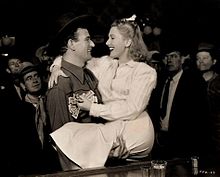
George Randolph Scott was an American film actor, whose Hollywood career spanned from 1928 to 1962. As a leading man for all but the first three years of his cinematic career, Scott appeared in dramas, comedies, musicals, adventures, war, horror and fantasy films, and Westerns. Out of his more than 100 film appearances, more than 60 of them were Westerns.

Jean Arthur was an American Broadway and film actress whose career began in silent films in the early 1920s and lasted until the early 1950s.

Hans Georg Conried Jr. was an American actor and comedian. He was known for providing the voices of George Darling and Captain Hook in Walt Disney's Peter Pan (1953), Snidely Whiplash in Jay Ward's Dudley Do-Right cartoons, Professor Waldo P. Wigglesworth in Ward's Hoppity Hooper cartoons, was host of Ward's live-action "Fractured Flickers" show and Professor Kropotkin on the radio and film versions of My Friend Irma. He also appeared as Uncle Tonoose on Danny Thomas' sitcom Make Room for Daddy, and twice on I Love Lucy.

The Devil and Miss Jones is a 1941 American comedy film directed by Sam Wood and starring Jean Arthur, Robert Cummings, and Charles Coburn. Its plot follows a department store tycoon who goes undercover in one of his Manhattan shops to ferret union organizers, but instead becomes involved in the employees' personal lives.

The First Traveling Saleslady is a 1956 American western comedy film directed by Arthur Lubin and starring Ginger Rogers, Carol Channing and Barry Nelson. Commercially unsuccessful, it was among the films that helped to close the already struggling RKO Pictures. Future western stars Clint Eastwood and James Arness have supporting roles in the film.
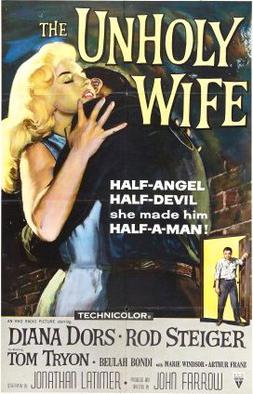
The Unholy Wife is a 1957 Technicolor film noir crime film produced and directed by John Farrow at RKO Radio Pictures, but released by Universal Pictures as RKO was in the process of ceasing its film activities. The film features Diana Dors, Rod Steiger, Tom Tryon and Beulah Bondi. The screenplay was written by William Durkee and Jonathan Latimer

The French Line is a 1953 American musical film starring Jane Russell made by RKO Radio Pictures, directed by Lloyd Bacon and produced by Edmund Grainger, with Howard Hughes as executive producer. The screenplay was by Mary Loos and Richard Sale, based on a story by Matty Kemp and Isabel Dawn. It was filmed in three strip technicolor and Dual strip polarized 3D during what many consider 3-D film's "golden era" of 1952-1954.

Felix Bressart was a German-born actor of stage and screen whose career spanned both Europe and Hollywood.

Willard Parker was an American film and television actor. He starred in the TV series Tales of the Texas Rangers (1955–1958).

Ride 'Em Cowboy is a 1942 film starring the comedy team of Abbott and Costello, Dick Foran, Anne Gwynne, Johnny Mack Brown, Ella Fitzgerald, Samuel S. Hinds, Douglas Dumbrille, Morris Ankrum, and directed by Arthur Lubin. The film focuses on Abbott and Costello as they play the role of two peanut vendors on the run from their boss. Despite their lack of knowledge in the trade, they get jobs as cowboys on a dude ranch. The film is set in the West.

William Alfred Seiter was an American film director.
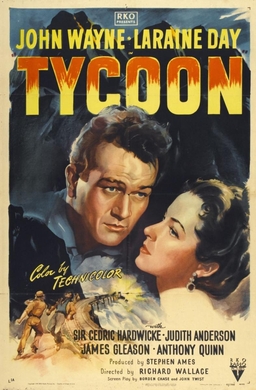
Tycoon is a 1947 American Technicolor romantic drama film directed by Richard Wallace and starring John Wayne, Laraine Day and Cedric Hardwicke. It was produced and distributed by RKO Pictures. It is based on the 1934 novel of the same name by Charles Elbert Scoggins.

I Married a Woman is a 1958 American comedy film made in 1956, directed by Hal Kanter, written by Goodman Ace, and starring George Gobel, Diana Dors, and Adolphe Menjou. The picture was produced by Gobel's company, Gomalco Productions. I Married a Woman also features John Wayne in a cameo role as himself. It was filmed in RKO-Scope and black and white except for one of Wayne's two scenes, which was shot in Technicolor. The film's original title was So There You Are. The film was a box-office disappointment, which hurt the careers of Dors and Gobel.
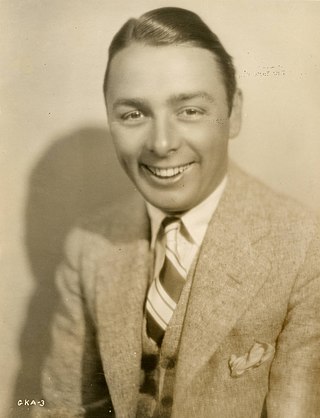
Arthur George Brest, known professionally as George K. Arthur, was an English actor and producer, born in Aberdeen, Scotland,. He appeared in more than 50 films between 1919 and 1935, and is best known as the diminutive half of the comedy team of Dane & Arthur.

Artie A. Ortego was an American actor. He appeared in more than 240 films between 1912 and 1955. Ortego portrayed cowboys, henchmen and American Indians in a large number of westerns and performed horse riding stunts. He was also a stunt double for Ramón Novarro in The Barbarian (1933), which is set in Cairo and also stars Myrna Loy.
Robert Fellows or Robert M. Fellows was an American film producer who was once a production partner with John Wayne and later with Mickey Spillane.
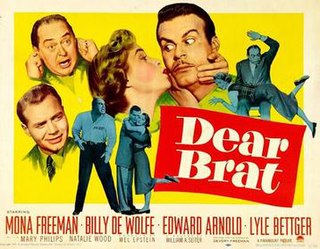
Dear Brat is a 1951 American comedy film directed by William A. Seiter and starring Mona Freeman and Billy De Wolfe. It is the third in a series following Dear Ruth (1947) and Dear Wife (1949).

Blondie's Blessed Event is a 1942 American comedy film directed by Frank R. Strayer and starring Penny Singleton, Arthur Lake, and Larry Simms. It is the 11th of the Blondie films. It was the first to feature the character of Cookie.

Edward Arthur Killy was an American director, assistant director and production manager in films and television. He was one of the few individuals to be nominated for the short-lived Academy Award for Best Assistant Director. During his 30-year career he worked on over 75 films and television shows.

Frank Redman was an American cinematographer from the end of the silent era through the 1960s. During his almost 40-year career, he shot over 60 feature films, as well as several film shorts and serials. In the 1950s, he transitioned to the smaller screen, where he was most well known for his work on the iconic television show, Perry Mason from the end of the 1950s through 1965.

